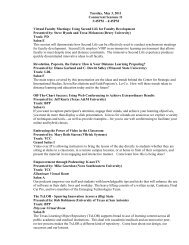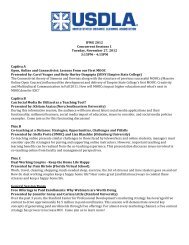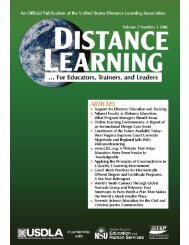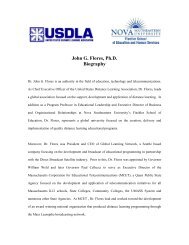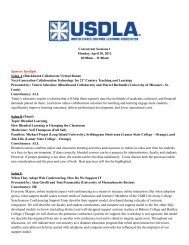United States Distance Learning Association
United States Distance Learning Association
United States Distance Learning Association
- No tags were found...
You also want an ePaper? Increase the reach of your titles
YUMPU automatically turns print PDFs into web optimized ePapers that Google loves.
And Finally … continued from page 100<br />
dotal reports, where is the evidence to support<br />
this “wisdom”<br />
For example, let’s talk about the college<br />
course. According to the century-old standard<br />
of the course unit, sometimes called<br />
the Carnegie Unit, a one-credit course<br />
should have 750 minutes of instruction by<br />
a teacher to students in a classroom. This<br />
equates to fifteen 50-minute classes.<br />
A three-credit class would have 2,250<br />
minutes of classroom instruction, or fortyfive<br />
50-minute classes often scheduled<br />
over a 15-week semester—three classes<br />
each week for 15 weeks. Typically, a student<br />
would be expected to spend 2 hours<br />
outside of class for every hour in the classroom—time<br />
spent studying or completing<br />
assignments.<br />
What about instructors Well, if students<br />
are in the classroom for forty-five 50-<br />
minute sessions, the instructor probably is<br />
also. And, most agree that for every hour<br />
the college professor is in class he or she<br />
probably needs to spend 2 hours preparing<br />
and grading, so teacher and student time<br />
required to complete a typical college<br />
course is roughly equivalent.<br />
Obviously, in a distance-delivered<br />
course, instructors do not attend a traditional<br />
class—there often is no formal class,<br />
especially in an asynchronous course.<br />
Thus, instructor time can be reallocated<br />
from presenting to preparing, from lecturing<br />
to posting, and from explaining to<br />
interacting.<br />
Does this change really happen In<br />
some cases, possibly not, since there is a<br />
small but growing number of online<br />
instructors who teach asynchronous<br />
courses who are reporting that they need<br />
to allocate less time to teaching online to<br />
accomplish an equivalent level of involvement<br />
as they contributed to their traditional<br />
classes. As a matter of fact, a rule of<br />
thumb has been proposed—for every 10%<br />
of the content of a class that is converted<br />
from face-to-face instruction there is a 5%<br />
saving in instructor time, up to a total possible<br />
saving of 25%. Thus, for an experienced<br />
instructor, teaching an online course<br />
that he or she has taught several times,<br />
there is a potential saving of about 30<br />
hours for a typical three-credit college<br />
course.<br />
Obviously, this “dirty little secret” needs<br />
to be studied carefully and in a scientifically<br />
appropriate manner—the field needs<br />
research dealing with instructor time.<br />
And finally, as Victor Hugo said in his<br />
Histoire d’un Crime (1852), “An invasion of<br />
armies can be resisted, but not an idea<br />
whose time has come.”<br />
DO EXPERIENCED DISTANCE EDUCATORS NEED TO SPEND LESS TIME TO BE EQUIVALENTLY<br />
EFFECTIVE ANOTHER RESEARCH QUESTION FOR DISTANCE EDUCATION SCIENTISTS.<br />
Volume 4, Issue 4 <strong>Distance</strong> <strong>Learning</strong> 99





